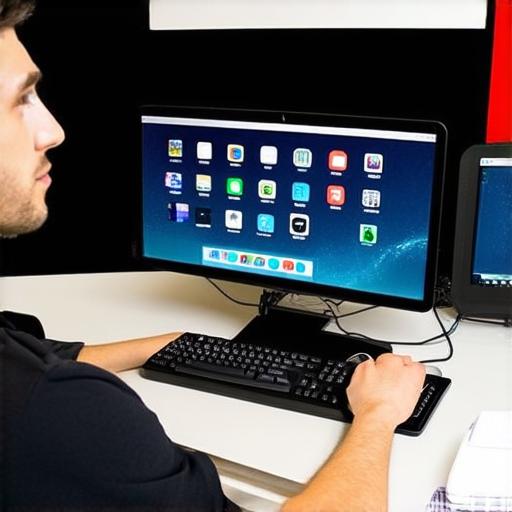As an iOS developer, you are constantly looking for ways to optimize your workflow and increase productivity. One of the most common challenges faced by developers is having to switch between different platforms to develop for various devices. This can be especially frustrating when you need to test your apps on a computer, which requires additional software and setup. In this comprehensive guide, we will explore how to operate iOS applications on a computer, including the best methods, tools, and workflows to help you streamline your development process and stay ahead of the competition.
Introduction
Why Develop for iOS on a Computer?
Why Develop for iOS on a Computer?
Before we dive into the specifics of operating iOS applications on a computer, let’s first explore why this is an important topic for developers. There are several reasons why you might need to develop for iOS on a computer, including:
- Testing: Testing your apps on different devices and platforms can be time-consuming and expensive. Developing on a computer allows you to test your apps quickly and efficiently, without having to purchase multiple physical devices.
- Debugging: Debugging your apps is an essential part of the development process. When developing for iOS on a computer, you can use advanced debugging tools to identify and fix issues in your code, saving time and effort later in the development process.
- Prototyping: Prototyping your app ideas can help you visualize how they will look and function on different devices and platforms. Developing on a computer allows you to create high-fidelity prototypes that can be easily shared with clients or team members.
- Collaboration: Collaborating with other developers or designers can be challenging when working on different platforms. Developing on a computer allows you to work together seamlessly, using the same tools and software.
The Challenges of Developing for iOS on a Computer
While developing for iOS on a computer has its advantages, it also comes with several challenges. These include:
- Compatibility issues: Not all iOS applications are compatible with computer operating systems, which can limit your ability to test and develop for certain devices.
- Software requirements: Developing for iOS on a computer requires specific software, including the Xcode IDE, which can be expensive and time-consuming to install.
- Setup and configuration: Setting up and configuring your development environment on a computer can be complex and time-consuming, especially if you are new to development or unfamiliar with the tools and software required.
The Best Methods for Developing for iOS on a Computer
Method 1: Using an Emulator
An emulator is a software program that allows you to run an operating system or application on a different platform. There are several emulators available for iOS development, including:
- Xcode: Xcode is the official IDE for iOS development and includes an emulator that allows you to test your apps on different devices and platforms.
- iOS Simulator: iOS Simulator is a free and open-source emulator for macOS that allows you to simulate the behavior of different iOS devices and operating systems.
- Appium: Appium is a cross-platform automation tool that can be used to test and develop apps on multiple platforms, including iOS and Android. It uses an emulator to simulate iOS devices on a computer.
Method 2: Using a Physical Device
While using an emulator is convenient, it can’t replace the experience of developing on a real device. If you have access to a physical iOS device, you can develop for iOS on a computer using the following methods:
- Using a USB cable: You can connect your iOS device to your computer using a USB cable and use the Xcode IDE or other development tools to develop for your device.
- Using a remote debugging tool: Remote debugging tools, such as Fastlane, allow you to debug your apps on a physical device from your computer. This method requires a compatible device and the appropriate tools and software.
Method 3: Using a Virtual Machine
A virtual machine is a software program that allows you to run an operating system or application on a computer. There are several virtual machines available for iOS development, including:
- VirtualBox: VirtualBox is a free and open-source virtualization tool that can be used to run iOS on a computer. It requires a compatible device and the appropriate software and tools.
- Parallels Desktop: Parallels Desktop is a commercial virtualization tool for macOS that allows you to run Windows or other operating systems on your Mac. It includes an emulator for iOS development.
The Tools You Need to Develop for iOS on a Computer

In addition to the methods discussed above, there are several tools you will need to develop for iOS on a computer. These include:
- Xcode: Xcode is the official IDE for iOS development and includes an emulator, debugging tools, and other features designed specifically for developing for iOS.
- iOS Simulator: As mentioned above, iOS Simulator is a free and open-source emulator for macOS that allows you to simulate the behavior of different iOS devices and operating systems.
- Fastlane: Fastlane is an automation tool for iOS development that includes remote debugging capabilities, allowing you to debug your apps on a physical device from your computer. It requires a Mac and can be installed using the CocoaPods package manager.
- TestFlight: TestFlight is a beta testing platform for iOS and macOS applications. It allows you to test your app with a group of beta testers before releasing it to the public. It requires an Apple Developer account and can be integrated into your development workflow using Xcode or other tools.
